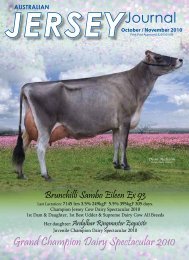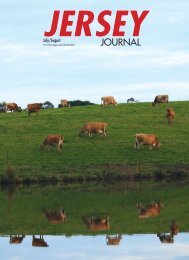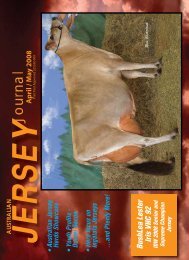Australian Dairy Herd Improvement Report 2010.pdf
Australian Dairy Herd Improvement Report 2010.pdf
Australian Dairy Herd Improvement Report 2010.pdf
You also want an ePaper? Increase the reach of your titles
YUMPU automatically turns print PDFs into web optimized ePapers that Google loves.
2010 In Review<br />
NHIA Chairman’s report<br />
By Gordon Stewart<br />
NHIA Chairman<br />
History is made by asking the right question at the<br />
right time.<br />
Almost two years ago, at a National <strong>Herd</strong><br />
<strong>Improvement</strong> Association (NHIA) Member’s Forum<br />
in Shepparton, Victoria, the question was asked,<br />
“Are we doing a good enough job with dairy data in<br />
Australia and can we improve?”<br />
There was consensus that there was room for<br />
improvement in the way we organised dairy data<br />
and at that meeting the NHIA Working Group on<br />
<strong>Dairy</strong> Data was formed with a brief to investigate the<br />
matter further.<br />
Since that time, the Working Group has expended<br />
considerable time and effort in pursuit of the goal<br />
of building industry consensus on a way forward.<br />
On behalf of NHIA members, I would like to express<br />
my gratitude to the Group for its dedication and<br />
hard work. Ably led by Dr Matthew Shaffer (Holstein<br />
Australia) as Chairman, the Group also included<br />
Daniel Abernethy (ADHIS), Leon Giglia (Farmwest),<br />
Peter Van Elzakker (BOS Trading) and NHIA General<br />
Manager, Carol Millar.<br />
Significant financial investment<br />
Some may ask why NHIA would get involved in this<br />
project but, in my view, the answer is obvious.<br />
One of NHIA’s five Statements of Purpose is to “lead<br />
the continual development of the herd improvement<br />
industry” and there is no better place for us to display<br />
leadership than in the area of dairy data, which has<br />
an enormous role to play in the businesses of our<br />
members and their farmer customers.<br />
To this end, the Working Group identified the need<br />
to engage an independent consultant to carry out<br />
a stocktake of the current arrangements for dairy<br />
data in Australia, and establish the case for strategic<br />
improvement and identify options for the future.<br />
The NHIA Board stepped up to the plate and dug<br />
deep into Association resources in order to fund the<br />
consultant’s report.<br />
At this point, we must also acknowledge Holstein<br />
Australia financial support for this report, for which<br />
we are most grateful.<br />
Both organisations have had the courage to “put<br />
their money where their mouth is” and the result is<br />
<strong>Report</strong> for NHIA <strong>Dairy</strong> Industry Data Project which was<br />
released in July 2010.<br />
This report represents the most comprehensive<br />
study of the dairy data situation ever undertaken<br />
in Australia. In addition, it was made available to<br />
any person or organisation with an interest in dairy<br />
data. This openness and transparency has been a<br />
characteristic of all the endeavors of the NHIA and its<br />
Working Group. The report remains available for use<br />
by the entire dairy industry.<br />
<strong>Dairy</strong> data has many uses<br />
Genetic evaluation and the production of <strong>Australian</strong><br />
Breeding Values (ABVs) is an obvious benefit of the<br />
data collected from tested herds, but there are others.<br />
There is an important farm benefit in being able<br />
to individually identify cows and monitor their<br />
performance, whether farmers are feeding for<br />
production, using cell count information to earn<br />
a premium milk price or deciding which cows to<br />
cull or sell. Farmers who herd test understand the<br />
enormous value of this data and how they can use<br />
this knowledge to generate greater profit.<br />
There is also a collective benefit in gathering<br />
data from as many farms as possible so we can<br />
understand trends in the dairy industry. It is vital to<br />
industry leaders making strategic decisions about<br />
future priorities. The more data available, the more<br />
informed decisions can be made about industry<br />
priorities. This applies to setting dairy research<br />
priorities, monitoring food safety and milk quality,<br />
and for animal welfare and bio-security.<br />
The whole way through the supply chain from farm<br />
to factory to boardrooms, more data means greater<br />
knowledge and better decisions. In turn, this means<br />
greater value and profit to all in the dairy industry.<br />
2 <strong>Australian</strong> <strong>Dairy</strong> <strong>Herd</strong> <strong>Improvement</strong> <strong>Report</strong> 2010

















